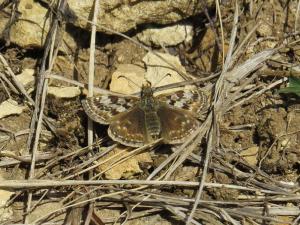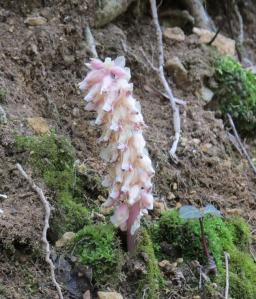The Bill Smylie butterfly reserve, on the western slopes of Cleeve Hill, the highest point of the Cotswolds, is somewhere I’ve been meaning to visit for a while. As it looked like very good butterfly weather yesterday, I decided to give it a go, There was no sign of any Duke of Burgundy butterflies, the species for which the site is best known, but several other species were present: Dingy Skipper (Erynnis tages) was the most numerous species, and I managed a number of half-decent photos.
 |
 |
Although Dingy Skipper is widespread in central and southern England, it tends to be confined to fairly good-quality sites. Its caterpillar feeds on Bird’s-foot Trefoil (Lotus corniculatus) and other related species in the pea family. Bird’s-foot Trefoil is a common species in limestone grassland that hasn’t been agriculturally “improved”, and it’s in these sites that Dingy Skipper does best, although it also occurs in patches of open habitat within other sites, e.g. woodland rides and clearings, particularly if there are bare open patches where adult can sunbathe. There are strong populations on the Cotswolds and the Mendips, however it is a species which is in decline. In the 1970s and 80s, it was found at several sites in and around Bristol, but no longer occurs here. It is possibly still found on the east edge of Bristol, near Rodway Hill, although the last records here on the National Biodiversity Network website are from 1998.
Dingy Skipper could be overlooked as a moth due to its dull colours: in fact there are several species of day-flying moth which look similar, such as the Burnet Companion (Euclidia glyphica). In fact, in evolutionary terms, butterflies are just a specialised day-flying group buried deep within the moth evolutionary tree. Skippers have in the past been thought not be closely related to the remaining butterflies, although DNA studies from the last decade show that this isn’t the case, and that all butterflies, including the skippers, arose from the same common ancestor, and that no moths evolved from this ancestor (in biological jargon, butterflies are ‘monophyletic’).
Bill Smylie reserve is a few miles northeast of Cheltenham, on the edge of the minor road that leads up to Cleeve Hill common:

